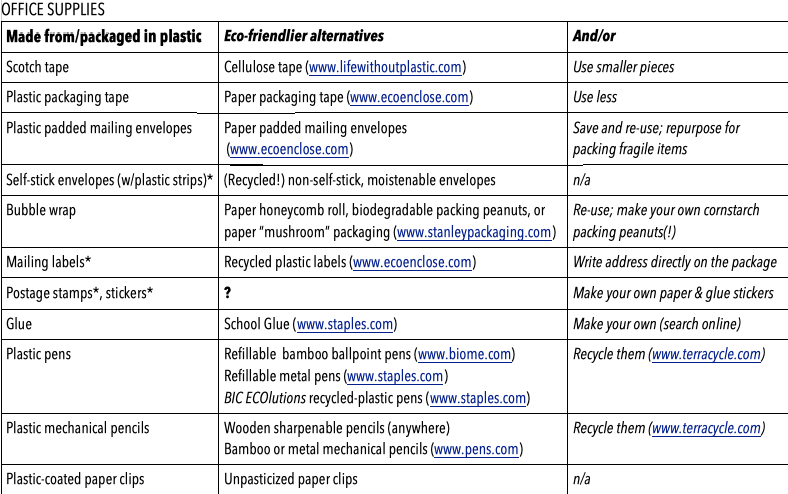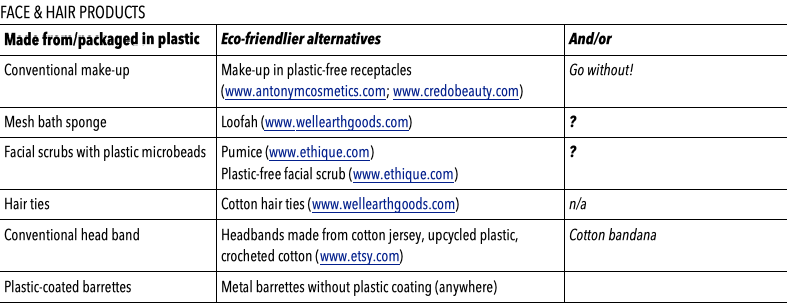Plastics Are Everywhere!
By Judith Glixon/
Yes, plastics are everywhere. For example, look around your home. You may be surprised how much plastic you find. Don't worry - no blame intended; we're all in the same predicament. At least we're beginning to do something about it. (If you haven't been inspired to yet, please watch this 1-minute video from the Conservation Law Foundation).
So far, I've written about the plastics/climate connection; general tips for reducing plastic waste; and ideas and resources for replacing plastics in our kitchens, bathrooms, and closets. This month we'll focus on other rooms in our homes. The question arises: "How do we choose which items to replace?" We can start with those we most frequently dispose of, such as pens, toothbrushes, dental floss, or packaging. If we keep in mind that mass-production of disposable plastic products only began in the mid-20th century, we can contemplate how we might manage without some of them. For each item we consider replacing, we can ask ourselves how previous generations lived without such an item:
- What did they do or use instead?
- In what ways did they have to learn to be resourceful?
- Did they use a comparable product that was made from more sustainable materials?
Then we can begin to search our souls:
- Do I have the fortitude to break from the status quo?
- Am I willing to try some of the items they may have used, or some newly developed, similarly less harmful replacements?
When purchasing alternatives to plastics, let's start by considering products made from materials such as metal, glass, wood,or bamboo. True, there can be social and environmental problems with the sourcing and production of these materials, too (which we won't go into here), but they generally aren't as globally destructive.
What about products made from recycled plastic? According to panelists on the 3/9/21 NERC (Northeast Recycling Council) webinar Plastic Film Recycling & End-Markets, if we want to increase the amount of plastics that will be recycled (instead of incinerated or dumped), we should increase demand for recycled plastics by buying more recycled-plastic goods. That said, unless we are using a dedicated microplastic-catching filter in the washer or dryer to limit the amount of plastic fibers that go down the drain and into our waterways (see www.sciencefocus.com/news/microplastics-laundry-filters-dramatically-reduce-fibres), we should avoid purchasing synthetic textiles altogether. (Also, for health reasons it's best to avoid food packaging made from any kind of plastic, virgin or recycled.)
Below are some commonly used plastic-based products paired with some less-harmful alternatives (and a sampling of vendors), along with related earthy-friendly practices. (A question mark [?**] under any heading indicates that I haven't yet come across any sustainable options.) This list is not exhaustive, so I welcome additional recommendations. Remember, if you can't find the products you're looking for, or believe a particular vendor's selections aren't truly eco-friendly, please take the time to let sellers or manufacturers know. (Note: The writer has no affiliation with the companies mentioned in this article, and in most cases has not yet tested these products. Websites are included purely for informational reasons, based on my research, and I make no guarantees regarding their quality or effectiveness.)

* These self-stick products use backing sheets called “release liners” which, in the paper recycling process must be separated out, raising the cost of recycling (Recycling Mystery: Label Backing Sheets (https://earth911.com/home-garden/label-backing-sheets)
*Speaking of laundry, here are three wonderful, new-to-me ideas for greatly reducing release of microplastics into our waterways:
- Washing machine microfiber filter (www.planetcare.org)
- Mesh, non-shedding clothes-washing bag for machine or by hand (https://us.guppyfriend.com)
- Favor regular cycle over delicate cycle. (Delicate cycle uses more water, allowing the release of many more microplastic fibers)


-Judith Glixon
